NVIDIA cuDF: GPU-Accelerated DataFrames
NVIDIA cuDF is an open source CUDA-X™ Data Science library that accelerates popular libraries like pandas, Polars, and Apache Spark on NVIDIA GPUs—delivering massive speedups for DataFrame operations with no code changes required. Built on highly optimized CUDA® primitives, cuDF taps into GPU parallelism and memory bandwidth to accelerate data processing and analytics workflows.
Get Started:
Key Features
Maximize Performance With NVIDIA GPUs
cuDF is purpose-built to maximize GPU performance, optimizing core DataFrame operations with low-level CUDA primitives that fully leverage the parallelism and memory bandwidth of NVIDIA GPUs.
Accelerate With Zero Code Changes
GPU acceleration can be seamlessly integrated into existing pandas, Polars, or Apache Spark workflows using API-compatible layers like cudf.pandas and the Polars GPU engine—no code changes required.
Integrate With the Python Data Science Ecosystem
cuDF interoperates effortlessly with popular Python data science libraries like cuPy, Numba, and scikit-learn, allowing you to build end-to-end GPU-accelerated workflows.
Handle Memory Efficiently
Built on the Apache Arrow format, cuDF utilizes highly efficient columnar data structures, vector processing, and zero-copy interfaces with other accelerated libraries, minimizing data movement overhead.
Process Larger Datasets With Unified Virtual Memory (UVM)
UVM allows cuDF to transparently manage data transfers between system RAM and GPU memory, enabling you to process datasets that exceed the VRAM of a single GPU without explicit memory management.
Scale to Distributed Architectures
DataFrame workflows can be scaled across multiple GPUs and compute nodes with cuDF—built for distributed processing in environments like Apache Spark.
Turn cuDF On for Massive GPU Performance Gains
Test Drive cuDF
pandas
pandas offers a flexible API for data manipulation. cuDF makes pandas more usable for medium to large datasets by accelerating operations on the GPU, with no code changes required.
Polars
Polars is known for its performance and memory optimizations. Experience even faster execution when you call the GPU engine powered by cuDF.
Apache Spark
Apache Spark is a powerful engine for large-scale data processing. Learn how to use GPUs to significantly boost performance and cost efficiency.
pandas Accelerated With cuDF
This section details how cuDF seamlessly integrates with and accelerates your existing pandas workflows.
Integrate cuDF directly into your environment to accelerate pandas. Follow these steps to get started.
Install cuDF for pandas
Quick Install With conda
1. If not installed, download and run the install script. This will install the latest miniforge:
wget "https://github.com/conda-forge/miniforge/releases/latest/download/Miniforge3-$(uname)-$(uname -m).sh" bash Miniforge3-$(uname)-$(uname -m).sh
2. Then install with:
conda create -n rapids-25.12 -c rapidsai -c conda-forge \
cudf=25.12 python=3.13 cuda-version=13.0Quick Install With pip
Install via the NVIDIA PyPI index:
pip install \
"cudf-cu13==25.12.*"See the complete install selector for docker, WSL2, and individual libraries.
Enable cuDF Acceleration of pandas With Zero Code Changes
cuDF implements zero-code-change acceleration through the cuDF.pandas module. This module is part of the cuDF package. Load it to seamlessly accelerate your existing pandas code. Enable it using one of these methods before importing or using pandas. For a step-by-step visual guide, watch this video.
To accelerate IPython or Jupyter notebooks, use the magic command:
%load_ext cudf.pandas import pandas as pd ...
To accelerate a Python script, use the Python module flag on the command line:
python -m cudf.pandas script.py import pandas as pd ...
If you can't use command-line flags, explicitly enable cudf.pandas via import:
import cudf.pandas cudf.pandas.install() import pandas as pd ...
From Minutes to Seconds: cuDF Accelerates pandas
Standard DuckDB data benchmark (5 GB) performance comparison between cudf.pandas and traditional pandas v2.2 (lower is better).
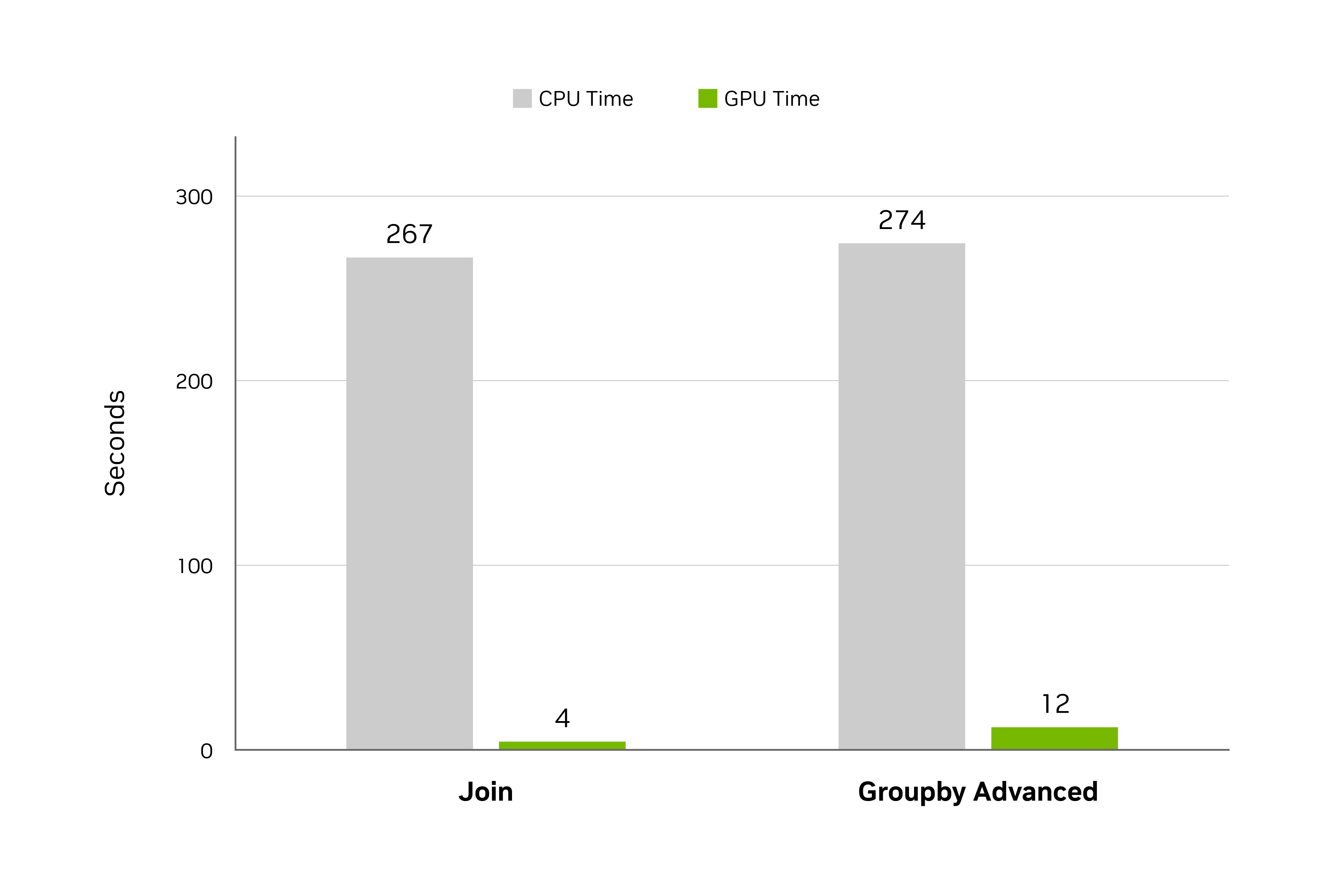
Specs: HW: NVIDIA L4, CPU: Intel Xeon 8480CL | SW: pandas v2.2.1, NVIDIA RAPIDS™ cuDF 24.02
Hands-On Tutorials: Accelerate pandas on Colab
cuDF comes preinstalled in Google Colab, making it incredibly easy to get started. Simply switch to a GPU runtime and enable cudf.pandas at the top of your notebook to instantly accelerate your pandas workflows. Explore these starter kits for hands-on examples:
Starter Kit: Build an Interactive Data Analytics Dashboard
This kit demonstrates how to create responsive dashboards using pandas code and PyViz libraries, directly addressing the lag when exploring large-scale data (e.g., 7.3M+ rows of geospatial data). See how GPU acceleration with cuDF makes interactive filters update near instantly with zero code changes.
Notebook: Build an Interactive Dashboard Notebook
Starter Kit: Process 18 Million Rows of Stock Data
This kit demonstrates how cuDF handles processing large volumes of time-series data in pandas, tackling bottlenecks like calculating simple moving averages with groupby().rolling(). See how GPU acceleration turns minutes of processing into seconds.
Notebook: Get Started With Accelerating Stock Data
Starter Kit: Process 8 GB of Text Data
This kit addresses the slowdowns pandas experiences from large string fields and memory-intensive operations like reading files, calculating string length, and merging DataFrames, providing massive end-to-end speedups.
Notebook: Get Started With Accelerating Stock Data
How cuDF Accelerates pandas
When cudf.pandas is enabled, it transforms how your pandas operations are executed, acting as a proxy that transparently intercepts your pandas calls. It attempts to execute these operations on the GPU first, utilizing cuDF’s highly optimized, GPU-accelerated functions. If a particular operation isn’t supported on the GPU, it falls back to the CPU, ensuring your code continues to run without errors. This seamless “GPU-first, CPU-fallback” mechanism allows you to continue using familiar pandas syntax and functions while benefiting from significant performance improvements.
This approach ensures that your existing pandas code, including operations within third-party libraries that use pandas, generally works as is, without requiring manual modifications to specifically target the GPU.
For a more granular explanation of the underlying architecture and how cudf.pandas achieves this seamless acceleration, refer to our documentation.

Polars Accelerated With cuDF
This section details how the Polars GPU engine, powered by cuDF, seamlessly integrates and accelerates your Polars workflows.
Integrate the Polars GPU engine directly into your environment to accelerate Polars. Follow these steps to get started.
Install Polars With GPU Support
Simply pip install Polars with the GPU feature flag.
pip install polars[gpu]
Configure Polars to Use the GPU Engine
Activate GPU acceleration for your Polars operations by configuring the engine. You can use the default GPU engine or customize it for finer control.
Default GPU Engine
Materialize the Polars LazyFrame into a DataFrame with the default GPU engine configuration by calling .collect(engine="gpu"):
import polars as pl
ldf = pl.LazyFrame({"a": [1.242, 1.535]})
print(
ldf.select(
pl.col("a").round(1)
).collect(engine="gpu")
)Custom GPU Engine
For finer control on the engine, you can pass a GPUEngine object with additional configurations like device details and verbosity to the engine=parameter:
import polars as pl
ldf = pl.LazyFrame({"a": [1.242, 1.535]})
gpu_engine = pl.GPUEngine(
device=0, # This is the default
raise_on_fail=True, # Fail loudly if can't execute on the GPU
)
print(
ldf.select(
pl.col("a").round(1)
).collect(engine=gpu_engine)
)Accelerate Polars Workflows Up to 13x
Top performing compute heavy queries with complex groupby and join operations
(PDS-H benchmark | 80 GB dataset)
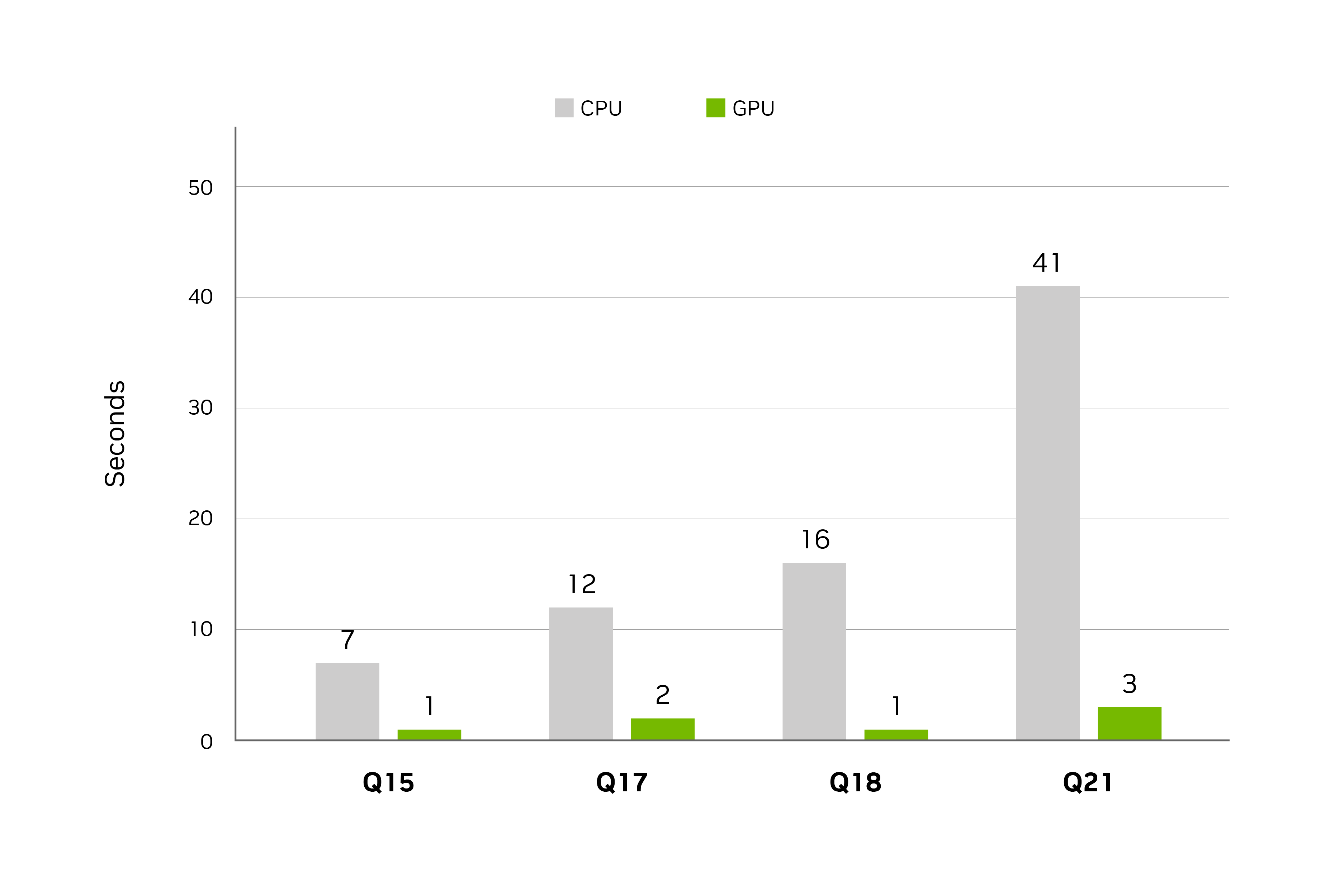
Query Number
Performance Improves as Data Size Grows
Query processing time across a range of dataset sizes
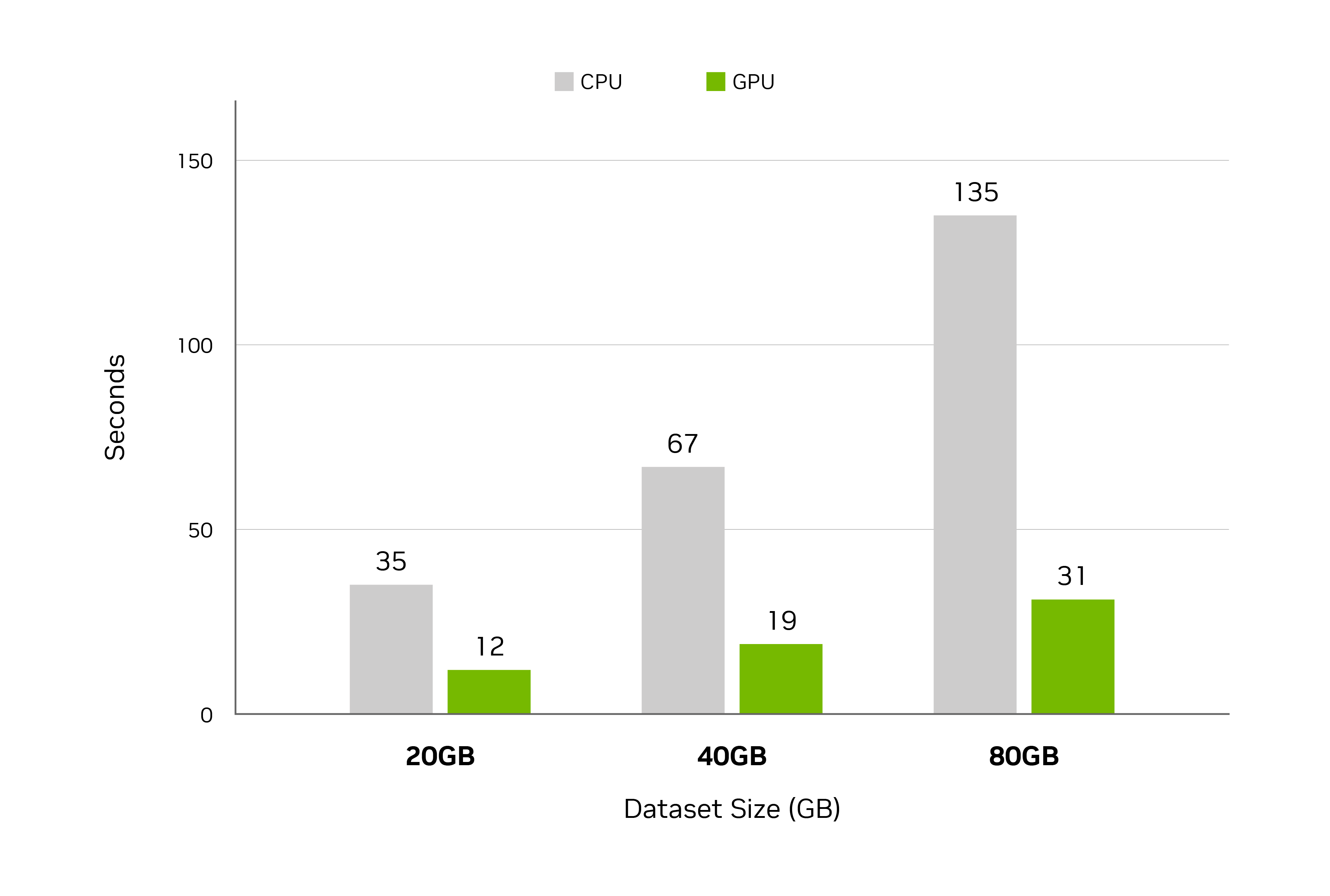
Specs: PDS-H benchmark | GPU: NVIDIA H100 | CPU: Intel Xeon W9-3495X (Sapphire Rapids) | Storage: Local NVME
Note: Note: PDS-H is derived from TPC-H but these results are not comparable to TPC-H results.
Hands-On Tutorials: Accelerate Polars on Colab
The Polars GPU engine is preinstalled in Google Colab, making it incredibly easy to get started. Simply switch to a GPU runtime and enable the GPU engine to instantly accelerate your Polars workflows. Explore these hands-on resources:
Starter Kit: Process 100 Million Rows of Transaction Data in Seconds
This kit demonstrates how the Polars GPU engine can process 100 million rows in under two seconds. Learn how, with it, you can tackle massive transaction datasets that typically cause slowdowns.
Notebook: Intro to the Polars GPU Engine
How cuDF Accelerates Polars
Polars is already a highly performant DataFrame library, designed with multi-threaded execution, advanced memory optimizations, and lazy evaluation. These features allow Polars to efficiently handle medium- to large-scale data out of the box
The Polars GPU engine takes these strengths further. By adding the speed of cuDF to the efficiency of Polars, you can achieve even faster execution, enabling the processing of hundreds of millions of rows in seconds.
Built directly into the Polars Lazy API, the GPU engine works by attempting to execute operations on the GPU first and falling back to the CPU if necessary. This approach ensures you can continue to use familiar Polars syntax and functions while benefiting from enhanced GPU acceleration.
For a deep dive into the architecture and underlying mechanisms of the Polars GPU Engine, check out the official Polars blog post.
Apache Spark Accelerated With cuDF
This section details how cuDF leverages NVIDIA GPUs to seamlessly integrate and significantly enhance the performance and cost efficiency of your Apache Spark workloads.
Acceleration of Apache Spark extract, transform, load (ETL) and machine learning workloads is designed to be straightforward, whether you're deploying on premises or in the cloud.
Launch Path
Follow our guide here. See below for a high-level overview:
Launch Spark with the RAPIDS Accelerator for Apache Spark plug-in jar and enable a configuration setting:
spark.conf.set('spark.rapids.sql.enabled','true')The following is an example of a physical plan with operators running on the GPU:
== Physical Plan == GpuColumnarToRow false +- GpuProject [cast(c_customer_sk#0 as string) AS c_customer_sk#40] +- GpuFileGpuScan parquet [c_customer_sk#0] Batched: true, DataFilters: [], Format: Parquet, Location: InMemoryFileIndex[file:/tmp/customer], PartitionFilters: [], PushedFilters: [], ReadSchema: struct<c_customer_sk:int>
Lightning Performance at a Fraction of the Cost
NVIDIA Decision Support Benchmark 3 TB
AWS EC2, Apache Spark 3.4.1, Spark RAPIDS release 24.04
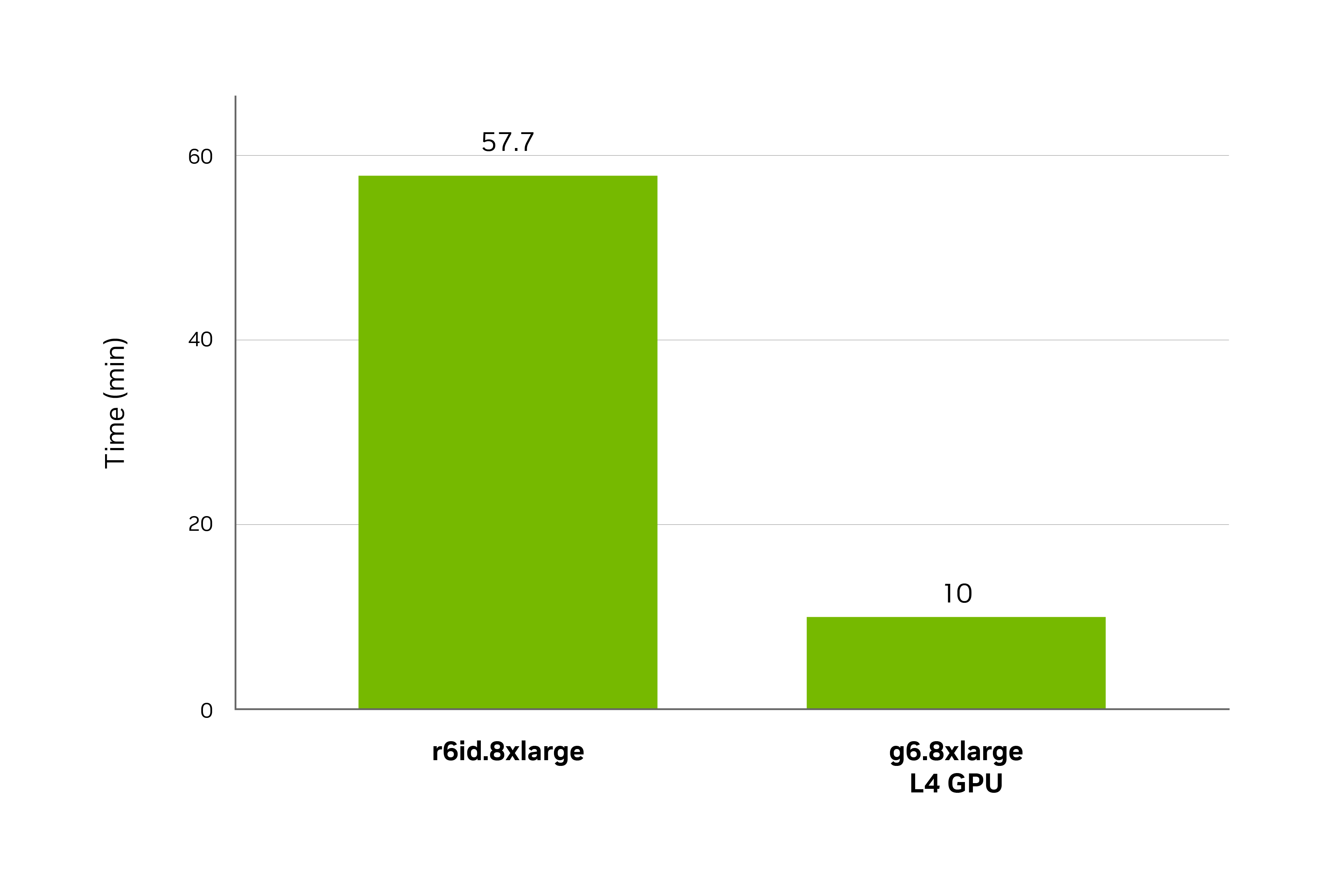
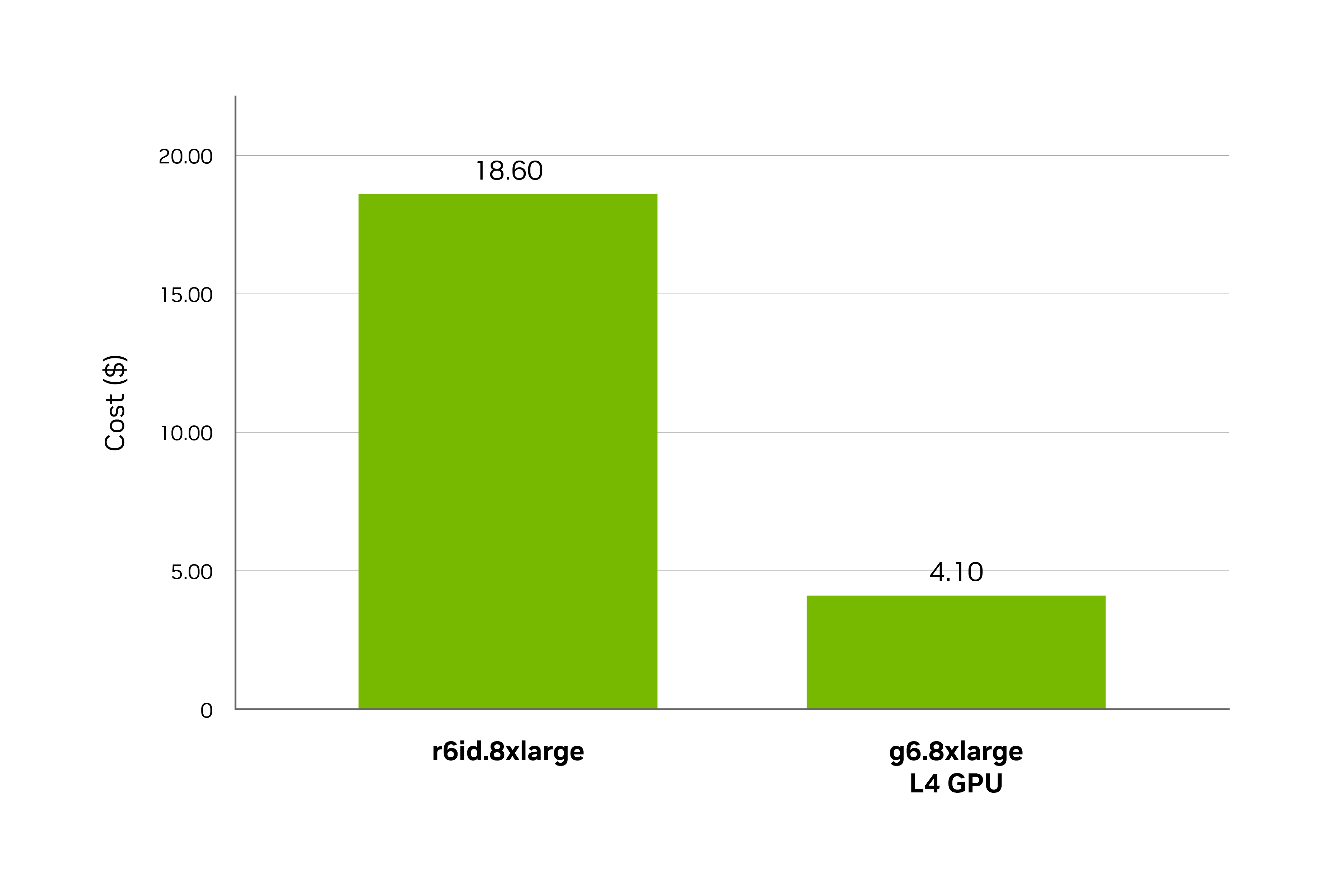
Cluster of 8x nodes in each setup:
CPU - r6id.8xlarge - 32 vCPU, 256GB, 1x1900 NVMe SSD, 12.5 Gb/s network
GPU - g6.8xlarge - 32vCPU, 1 L4 GPU, 128GB, NVMe SSD, 25 Gb/s network
* included NVAIE at $1/GPU/hr
Getting Started With cuDF Acceleration of Apache Spark
Learn how you can significantly accelerate enterprise-level data workloads, leading to substantial cost savings.
Scale Data Analytics With Apache Spark
Learn how GPUs accelerate enterprise-scale Apache Spark workflows to drive cost savings.
On-Demand GTC Session:: Accelerate Big Data Analytics on GPUs With the RAPIDS Accelerator for Apache Spark (01:27:34)
User Guide: RAPIDS Accelerator for Apache Spark
How cuDF Accelerates Apache Spark
NVIDIA cuDF enhances your Apache Spark workflows by integrating as a Spark plug-in. Once installed and configured, it automatically detects available GPUs and leverages them for supported operations.
It works by replacing the backend for Spark SQL and DataFrame operations with GPU-accelerated versions. If an operation isn’t supported on GPUs, the accelerator falls back to the standard Spark CPU implementation. This plug-in-based approach makes it easy to integrate with major Spark platforms, including AWS EMR, GCP Dataproc, OCI, and Databricks.
For a deeper-dive explanation of the underlying architecture, supported operations, and integration, refer to the user guide.

Data Science Training From NVIDIA
Join the Community
Ethical AI
NVIDIA believes Trustworthy AI is a shared responsibility and we have established policies and practices to enable development for a wide array of AI applications. When downloaded or used in accordance with our terms of service, developers should work with their supporting team to ensure their application meets requirements for the relevant industry and use case and addresses unforeseen product misuse.
Please report security vulnerabilities or NVIDIA AI Concerns here.